International Journal of Intelligent Systems and Applications @ijisa
Статьи журнала - International Journal of Intelligent Systems and Applications
Все статьи: 1214
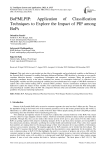
BoPMLPIP: Application of Classification Techniques to Explore the Impact of PIP among BoPs
Статья научная
This study tries to gain insight into the effect of demographic and psychological variables on the Bottom of the Pyramid (BoP) consumers for making Packaging Influenced Purchase (PIP) decisions by focusing on two specific consumer behaviour theories - compensatory consumption and consumers’ resistance. Being the product's face, packaging contributes heavily to the above mentioned two streams of consumption behaviour. A collection of ten demographic variables and four psychological variables have been administered on a sample of 1400 BoP consumers to explore their effect behind making PIP of selected FMCG products. Various classification techniques have been deployed to capture the impact of these variables. This experimental research design revealed that both demographic and psychological variables affect the PIP. The comparison between urban and rural BoPs potentially comes with the guidelines for practical marketing implications.
Бесплатно
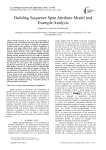
Building Sequence Span Attribute Model and Example Analysis
Статья научная
Parallel parsing is one of the key technologies of parallel system. Grammatical character affects the efficiency of parallel parsing and degree of difficulty of implement. Existing methods have problems as follows: Parallelism of grammar that adapt different data object is difference, if there is a large difference between considering attribute and analysis object structure, then affect efficiency. Specific grammar parallel parsing is systematically studied. Scanning parallel parsing methods from the new angle of sequence span after word lattice distortion. Considering sequence span attribute between some specific grammars makes parsing without changing structure and data of CYK table based on the structure of word lattice CYK initialization table; In passing item of the form [i , j , Bη•] in parallel parsing item table memory structure in circle structure is adopted chain breaking technology; When indexed optimize analysis, the key algorithms of increasing the feasibility and validity of sequence span attribute、reusing parsing tree、calculating of d space function and node separating are further studied, then unification and optimize effect between analysis table middle structure and data object structure is reached. New algorithm and implement strategy of parallel parsing of specific grammar is proposed.
Бесплатно
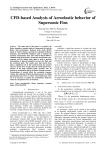
CFD-based Analysis of Aeroelastic behavior of Supersonic Fins
Статья научная
The main goal of this paper is to analyze the flutter boundary, transient loads of a supersonic fin, and the flutter with perturbation. Reduced order mode (ROM) based on Volterra Series is presented to calculate the flutter boundary, and CFD/CSD coupling is used to compute the transient aerodynamic load. The Volterra-based ROM is obtained using the derivative of unsteady aerodynamic step-response, and the infinite plate spline is used to perform interpolation of physical quantities between the fluid and the structural grids. The results show that inertia force plays a significant role in the transient loads, the moment cause by inertia force is lager than the aerodynamic force, because of the huge transient loads, structure may be broken by aeroelasticity below the flutter dynamic pressure. Perturbations of aircraft affect the aeroelastic response evident, the reduction of flutter dynamic pressure by rolling perturbation form 15.4% to 18.6% when Mach from 2.0 to 3.0. It is necessary to analyze the aeroelasticity behaviors under the compositive force environment.
Бесплатно
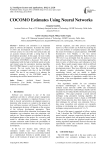
COCOMO Estimates Using Neural Networks
Статья научная
Software cost estimation is an important phase in software development. It predicts the amount of effort and development time required to build a software system. It is one of the most critical tasks and an accurate estimate provides a strong base to the development procedure. In this paper, the most widely used software cost estimation model, the Constructive Cost Model (COCOMO) is discussed. The model is implemented with the help of artificial neural networks and trained using the perceptron learning algorithm. The COCOMO dataset is used to train and to test the network. The test results from the trained neural network are compared with that of the COCOMO model. The aim of our research is to enhance the estimation accuracy of the COCOMO model by introducing the artificial neural networks to it.
Бесплатно
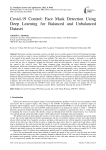
COVID-19 Control: Face Mask Detection Using Deep Learning for Balanced and Unbalanced Dataset
Статья научная
Facemask wearing is becoming a norm in our daily lives to curb the spread of Covid-19. Ensuring facemasks are worn correctly is a topic of concern worldwide. It could go beyond manual human control and enforcement, leading to the spread of this deadly virus and many cases globally. The main aim of wearing a facemask is to curtail the spread of the covid-19 virus, but the biggest concern of most deep learning research is about who is wearing the mask or not, and not who is incorrectly wearing the facemask while the main objective of mask wearing is to prevent the spread of the covid-19 virus. This paper compares three state-of-the- art object detection approaches: Haarcascade, Multi-task Cascaded Convolutional Networks (MTCNN), and You Only Look Once version 4 (YOLOv4) to classify who is wearing a mask, who is not wearing a mask, and most importantly, who is incorrectly wearing the mask in a real-time video stream using FPS as a benchmark to select the best model. Yolov4 got about 40 Frame Per Seconds (FPS), outperforming Haarcascade with 16 and MTCNN with 1.4. YOLOv4 was later used to compare the two datasets using Intersection over Union (IoU) and mean Average Precision (mAP) as a comparative measure; dataset2 (balanced dataset) performed better than dataset1 (unbalanced dataset). Yolov4 model on dataset2 mapped and detected images of masks worn incorrectly with one correct class label rather than giving them two label classes with uncertainty in dataset1, this work shows the advantage of having a balanced dataset for accuracy. This work would help decrease human interference in enforcing the COVID-19 face mask rules and create awareness for people who do not comply with the facemask policy of wearing it correctly. Hence, significantly reducing the spread of COVID-19.
Бесплатно
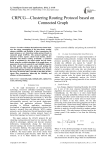
CRPCG—Clustering Routing Protocol based on Connected Graph
Статья научная
In order to balance the load between cluster head, save the energy consumption of the inter-cluster routing, enhance reliability and flexibility of data transmission, the paper proposes a new clustering routing protocol based on connected graph (CRPCG). The protocol optimizes and innovates in three aspects: cluster head election, clusters formation and clusters routing. Eventually, a connected graph is constituted by the based station and all cluster heads, using the excellent algorithm of the graph theory, to guarantee the network connectivity and reliability, improve the link quality, balance node energy and prolong the network life cycle. The results of simulation show that, the protocol significantly prolong the network life cycle, balance the energy of network nodes, especially in the phase of inter-cluster data transmission, improving the reliability and efficiency of data transmission.
Бесплатно
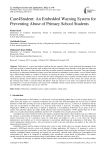
Care4Student: An Embedded Warning System for Preventing Abuse of Primary School Students
Статья научная
Child abuse is a social and medical problem that has negative effects on the individual development of the child and can lead to mental disorders such as depression and post-traumatic stress disorder in both short and long-term mental health. Therefore, any abuse that the child may encounter should be immediately intervened. This paper presents the design of an integrated embedded warning system that includes an embedded system module, a server-based module, and a mobile-based module as a solution to concerns of ensuring the safety of students in places where there are fewer safety measures. Our solution aims to ensure that the school management team is quickly informed about the adverse situation that primary school students may encounter and able to respond to them. In this context, this system activates the warning status when it correctly detects the phrases 'help me' and 'give it up'. Thus, any negativity that may be encountered in a closed environment is prevented. The embedded warning system detected correctly the phrase "help me" with 80%, and the phrase "give it up" with 75%.
Бесплатно
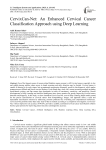
CervixCan-Net: An Enhanced Cervical Cancer Classification Approach using Deep Learning
Статья научная
One of the biggest causes of cancer-related fatalities among women is still Cervical cancer, especially in low and middle-income nations where access to broad screening and early detection may be limited. Cervical cancer is curable if detected in its early stages, but asymptomatic progression frequently results in late diagnosis, which makes treatment more difficult and lowers survival chances. Even though they work well, current screening methods including liquid-based cytology and Pap smears have drawbacks in terms of consistency, sensitivity, and specificity. Recent developments in Deep Learning and Artificial Intelligence have shown promise for greatly improving Cervical cancer detection and diagnosis. In this work, we have introduced CervixCan-Net, a novel Deep Learning based model created for the precise classification of Cervical cancer from histopathology images. Our approach offers a solid and dependable classification solution by addressing common problems like overfitting and computational inefficiency. CervixCan-Net performs better than many state-of-the-art models according to a comparison investigation. CervixCan-Net, with an impressive test accuracy of 99.83%, provides a scalable, automated Cervical cancer classification solution that has great promise for improving patient outcomes and diagnostic accuracy.
Бесплатно
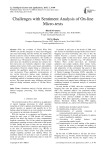
Challenges with Sentiment Analysis of On-line Micro-texts
Статья научная
With the evolution of World Wide Web (WWW) 2.0 and the emergence of many micro-blogging and social networking sites like Twitter, the internet has become a massive source of short textual messages called on-line micro-texts, which are limited to a few number of characters (e.g. 140 characters on Twitter). These on-line micro-texts are considered as real-time text streams. On-line micro-texts are extremely subjective; they contain opinions about various events, social issues, personalities, and products. However, despite being so voluminous in quantity, the qualitative nature of these micro-texts is very inconsistent. These qualitative inconsistencies of raw on-line micro-texts impose many challenges in sentiment analysis of on-line micro-texts by using the established methods of sentiment analysis of unstructured reviews. This paper presents many challenges and issues observed during sentiment analysis of On-line Micro-texts.
Бесплатно
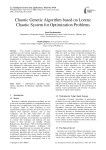
Chaotic Genetic Algorithm based on Lorenz Chaotic System for Optimization Problems
Статья научная
Very recently evolutionary optimization algorithms use the Genetic Algorithm to improve the result of Optimization problems. Several processes of the Genetic Algorithm are based on 'Random', that is fundamental to evolutionary algorithms, but important defections in the Genetic Algorithm are local convergence and high tolerances in the results, they have happened for randomness reason. In this paper we have prepared pseudo random numbers by Lorenz chaotic system for operators of Genetic Algorithm to avoid local convergence. The experimental results show that the proposed method is much more efficient in comparison with the traditional Genetic Algorithm for solving optimization problems.
Бесплатно
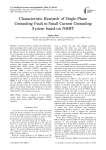
Статья научная
Transient analysis is carried out for the single-phase grounding fault in small current grounding system, the transient grounding current expression is derived, and the influence factors are analyzed. Introduces a method for non-stationary and non-linear signal analysis method –Hilbert Huang transform (HHT) to analyze the single phase grounding fault in small current grounding system, HHT can be better used to extract the abundant transient time frequency information from the non-stationary and nonlinear fault current signals. The empirical mode decomposition (EMD) process and the normalized Hilbert Huang transform (NHHT) algorithm are presented, NHHT is used to analyze and verify an example of the nonlinear and non-stationary amplitude modulation signals. Build a small current grounding system in the EMTP_ATP environment, by selecting the appropriate time window to extract the transient signals, NHHT is used to analyze the transient current signals, and the Hilbert amplitude spectrum and the Hilbert marginal spectrum of the zero sequence transient current signals are obtained. Finally, the influences of the fault phase and the grounding resistance on the time-frequency characteristics of the signals are analyzed.
Бесплатно
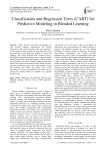
Classification and regression trees (CART) for predictive modeling in blended learning
Статья научная
Today, Internet and Web technologies not only provide students opportunities for flexible interactivity with study materials, peers and instructors, but also generate large amounts of usage data that can be processed and reveal behavioral patterns of study and learning. This study analyzed data extracted from a Moodle-based blended learning course, to build a student model that predicts course performance. CART decision tree algorithm was used to classify students and predict those at risk, based on the impact of four online activities: message exchanging, group wiki content creation, course files opening and online quiz taking. The overall percentage of correct classifications was about 99.1%, proving the model sensitive to identify very specific groups at risk.
Бесплатно
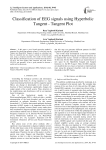
Classification of EEG signals using Hyperbolic Tangent-Tangent Plot
Статья научная
In this paper, a novel signal processing method is suggested for classifying epileptic seizures. To this end, first the Tangent and Hyperbolic Tangent of signals are calculated and then are classified into two classes: normal (or interictal) and ictal, using a proposed classifier. The results of this method show that the classification accuracy of normal and ictal classes (97.41%) has been higher than interictal and ictal classes (92.83%) and generally, it has a good potential to become a useful tool for physicians.
Бесплатно
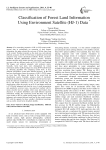
Classification of Forest Land Information Using Environment Satellite (HJ-1) Data
Статья научная
For researching properties of HJ-1A CCD camera multi-spectral data in performance on extraction of land features information, this paper selected the east area of NiLeke forest farm in the western Tianshan mountain as the study area, and analyzed different accuracies for HJ-1A CCD data in identifying forest land categories using various classification methods. Firstly, maximum-likelihood classifier, Mahalanobis distance classifier, minimum distance classifier and K-means classifier were used to category land use types with two different scales on HJ-1A CCD1 and Landsat5 TM images, and analyzed separately with confusion matrix. Secondly, forest land types were distinguished by texture information and the smallest polygon size using K-NN method based on clustering algorithm. The comparing results show: at first, different classification system have different accuracy. In the first land use classification system, the accuracy of HJ-1A CCD1 images are lower than TM images, but higher in the second land use classification system. Secondly, accuracy result of maximum-likelihood classification is the best method to classify land use types. In the first land use classification system, TM total accuracy is up to 85.1% and Kappa coefficient is 0.8. In the second land use classification system, the result is up to 85.4% and kappa coefficient is 0.74.Thirdly, judgment both from the view of visual interpretation and quantitative accuracy testes, non-supervised method with K-means classifier has low qualities where many land features have characters of scattered distribution and small different spectrum information. Finally, the experiment proved that there were good vector results on HJ-1A remote sensing image in the view of visual judgment, and extracted deferent forest land by the overall accuracy 87% with the supports by those variables’ distribution knowledge, such as conifer, mixed forest, broadleaf, shrubby.
Бесплатно
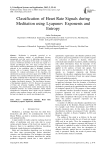
Classification of Heart Rate Signals during Meditation using Lyapunov Exponents and Entropy
Статья научная
Meditation is commonly perceived as an alternative medicine method of psychological diseases management tool that assist in alleviating depression and anxiety disorders. The purpose of this study is to evaluate the accuracy of different classifiers on the heart rate signals in a specific psychological state. Two types of heart rate time series (before, and during meditation) of 25 healthy women are collected in the meditation clinic in Mashhad. Nonlinear features such as Lyapunov Exponents and Entropy were extracted. To evaluate performance of the classifiers, the classification accuracies and mean square error (MSE) of the classifiers were examined. Different classifiers were tested and the studies confirmed that for the heart rate signals, Quadratic classifier trained on Lyapunov Exponents and Entropy results in higher classification accuracy. The classification accuracy of the Quadratic classifier is 92.31%. However, the accuracies of Fisher and k-Nearest Neighbor (k-NN) classifiers are encouraging. The classification results demonstrate that the dynamical measures are useful parameters which contain comprehensive information about signals and the Quadratic classifier using nonlinear features can be useful in analyzing the heart rate signals in a specific psychological state.
Бесплатно
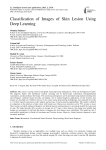
Classification of Images of Skin Lesion Using Deep Learning
Статья научная
Skin cancer is among common and rapidly increasing human malignancies, which can be diagnosed visually. The diagnosis begins with preliminary medical screening and by dermoscopic examination, histopathological examination, and proceeding to the biopsy. This screening and diagnosis can be automated using machine learning tools and techniques. Artificial neural networks are helping a lot in medical diagnosis applications. In this research, skin images are classified into 7 different classes of skin cancer using deep learning methodology, then analyzed the results w.r.t to their respective precision, recall, support, and accuracy to find its practical applicability. This model is efficient in comparison to the detection of skin cancer with human eyes. Human eyes detection can be 79% accurate at most. Thus, having a scientific method of diagnosis can help the doctors and practitioners to accurately identify the cancer and its type. The model provides 80% accuracy on average for all 7 types of skin diseases, thus being more reliable than human eye examination. It will help the doctors to diagnose the skin diseases more confidently. The model has only 2 misclassified predictions for Basal cell carcinoma and Vascular lesions. However, Actinic keratosis diagnosis is most accurately predicted.
Бесплатно
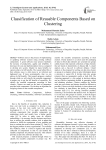
Classification of Reusable Components Based on Clustering
Статья научная
Software reuse is the process of implementing or updating software systems using existing software components. A good software reuse process facilitates the increase of productivity, quality and reliability. It decreases the cost and implementation time as compared to develop new system. Despite its many benefits we cannot achieve its full benefits. The reason behind this is that software reuse is often done in an informal and haphazard way. If done systematically, then we can achieve its full benefits. This research proposes a method through which we will classify the reusable components in proper way to get the full benefits of reusability. We classify the reusable components according to their clusters. Clusters are made on the basis of parameters provided with components. We develop an algorithm for assigning clusters to the reusable components.
Бесплатно
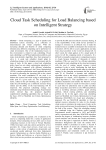
Cloud Task Scheduling for Load Balancing based on Intelligent Strategy
Статья научная
Cloud computing is a type of parallel and distributed system consisting of a collection of interconnected and virtual computers. With the increasing demand and benefits of cloud computing infrastructure, different computing can be performed on cloud environment. One of the fundamental issues in this environment is related to task scheduling. Cloud task scheduling is an NP-hard optimization problem, and many meta-heuristic algorithms have been proposed to solve it. A good task scheduler should adapt its scheduling strategy to the changing environment and the types of tasks. In this paper a cloud task scheduling policy based on ant colony optimization algorithm for load balancing compared with different scheduling algorithms has been proposed. Ant Colony Optimization (ACO) is random optimization search approach that will be used for allocating the incoming jobs to the virtual machines. The main contribution of our work is to balance the system load while trying to minimizing the make span of a given tasks set. The load balancing factor, related to the job finishing rate, is proposed to make the job finishing rate at different resource being similar and the ability of the load balancing will be improved. The proposed scheduling strategy was simulated using Cloudsim toolkit package. Experimental results showed that, the proposed algorithm outperformed scheduling algorithms that are based on the basic ACO or Modified Ant Colony Optimization (MACO).
Бесплатно
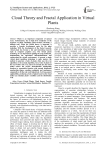
Cloud Theory and Fractal Application in Virtual Plants
Статья научная
Plants is an important component of natural scene. Unfortunately, due to high level complexity of the structure of plant, simulating plant becomes extremely a difficult task. When the fractal theory is imported, it provides a broader development space for the plant modeling. With the development of the fractal research, virtual plant has become a hot and interesting research topic in computer graphics area. The virtual plants technology is very important in guiding the crop production, implementing the agriculture informationization and constructing the virtual environment. At present a single virtual plant modeling technology is quite mature, the method to generate a body of plants often uses the even algorithm or the normal algorithm, but a body of plants in the real world is not even, and is not normal also, the cloud model relaxes the precise determination membership function to expectation function with normal distributed membership degree, combines ambiguity and randomness organically to fit the real world objectively. So it has general applicability, producing a body of plants based on the cloud model can simulate plant's condition and the distribution well.
Бесплатно
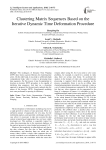
Clustering matrix sequences based on the iterative dynamic time deformation procedure
Статья научная
The techniques of Dynamic Time Warping (DTW) have shown a great efficiency for clustering time series. On the other hand, it may lead to sufficiently high computational loads when it comes to processing long data sequences. For this reason, it may be appropriate to develop an iterative DTW procedure to be capable of shrinking time sequences. And later on, a clustering approach is proposed for the previously reduced data (by means of the iterative DTW). Experimental modeling tests were performed for proving its efficiency.
Бесплатно

